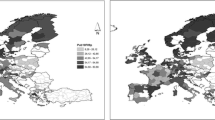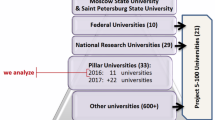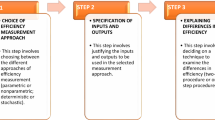Abstract
The objective of this study consists, firstly, of quantifying differences between Spanish universities’ output (in terms of publications and citations), and secondly, analysing its determinants. The results obtained show that there are factors which have a positive influence on these indicators, such as having a third-cycle programme, with public financing obtained in competitive selection procedures, having a large number of full-time researchers or involvement in collaborations with international institutions. However, other factors which appear to have the opposite effect were also noted. These include a higher number of students per lecturer or a lower proportion of lecturers with recognised six-year periods.
Similar content being viewed by others
References
Adams, J. D., Clemmons, J. R. (2006), The Growing Allocative Inefficiency of the U.S. Higher Education Sector, mimeo. Available at http://www.nber.org/:_sewp/references.html
Bauwens, L., Kirman, A., Lubrano, M., Protopopescu, C. (2000), Some Methodological Aspects for Rankings European Economic Departments a Statistical Approach, mimeo.
Bauwens, L., Kirman, A., Lubrano, M., Protopopescu, C. (2002), Ranking European Economics Departaments: A Statistical Approach, mimeo.
Bergantińos, G., Da Rocha, J. M., Polomé, P. (2002), La investigación espańola en economía 1995–1999, Investigaciones Económicas, XXVI(2), pp. 373–392.
Cameron, A., Trivedi, P. (1990), Regression-based tests for overdispersion in the Poisson Model, Journal of Econometrics, 46: 347–364.
Cameron, B. D. (2005), Trends in the usage of ISI bibliometric data: Uses, abuses, and implications, Libraries and the Academy, 5: 105–125.
Cherchye, L., Vanden Abeele, P. (2005), On research efficiency. A micro analysis of Dutch university research in Economics and Business Management, Research Policy, 34: 495–416.
Combes, P., Linnemer, L. (1999), The Publication of Research Papers in France. An Approach Using Citations. CERAS working paper 00-04.
Combes, P., Linnemer, L. (2000), The Publication of Research Papers in France, An Approach Using the Quality of Journals. CERAS working paper 99-13.
Conroy, M., Dusansky, R. (1995), The productivity of economics departments in the US: Publications in core journals. Journal of Economic Literature, 33: 1966–1971.
Coupé, T. (2003), Revealed performances. Worldwide rankings of economists and economics departments, 1990–2000. Journal of the European Economic Association, 1: 1309–1345.
Davis, J., Huston, J., Moore Patterson, D. (2001), Scholarly output of economists: A description of publishing patterns. Atlantic Economic Journal, 29: 341–349.
Dusansky, R., Vernon, C. (1998), Rankings of U.S. Economics Departments. Journal of Economic Perspectives, 12: 157–170.
Ehrenberg, R. G. (2003), Studying ourselves: The academic labor market, Journal of Labor Economics, 21: 267–287.
Faria, J. R. (2001), Rent seeking in academia: The consultancy disease. The American Economist, 45: 69–74.
Fox, K. J., Milbourne, R. (1999), What determines research output of academic economists? Economic Record, 75: 256–267.
Fusfeld, D. R. (1956), The origins of the contributors to the AER during the 50s. American Economic Review, 46: 642–644.
García, P., Lafuente, A., Montañés, A., Sanz, F. (1999a), Producción científica en economía según publicaciones en revistas internacionales: el caso de España. Papeles de Economía Española, 81: 49–57.
García, P., Montañés, A., Sanz, F. (1999b) La investigación en economía en España: Mercado nacional ?versus? Mercado internacional. Revista de Economía Aplicada, 20: 167–187.
Graves, P. E., Marchand, J. R., Thompson, R. (1982), Economics departmental rankings, research incentives, constraints and efficiency, American Economic Review, 72: 1131–1141.
Huettner, D. A., Clark, W. (1997), Comparative research productivity measures for Economics Departments. Journal of Economic Education, 28: 272–278.
Johnes, G. (1988), Determinants of research output in economics departments in British-Universities, Research Policy, 17: 171–178.
Kalaitzidakis, P., Mamuneas, T., Stengos, T. (2003), Rankings of academic journals and institutions in economics. Journal of the European Economics Association, 1: 1346–1366.
Kalaitzidakis, P., Mamuneas, T., Savvides, A., Stengos T. (2004), Research spillovers among European and North-American economics departments. Economics of Education Review, 23: 191–202.
Lubrano, M. (2001), Ranking Economic Departments in Belgium, France and Spain: Partial Results from a More General Report. http://durandal.cnrs-mrs.fr/PP/lubrano/rankings/ranking.htm
Martínez Cabrera, M. (2000), Análisis de la eficiencia productiva de las instituciones de educación superior. Papeles de Economía Española, 86: 179–191.
Maske, K. L., Durden, G. C., Gaynor, P. (2003), Determinants of scholarly productivity among male and females economists. Economic Inquiry, 41: 555–564.
Mein, D. G. (2002), Research productivity and career status. Applied Economics Letters, 9: 809–815.
Moya-Anegon, F. (Ed.) (2005), Indicadores bibliométricos de la actividad científica española, FECYT, Madrid.
Sanz, E., García, C., García, A., Modrego A. (1999), La investigación española en Economía a través de las publicaciones nacionales e internacionales en el período 1990–1995. Revista de Economía Aplicada, 20: 113–137.
Sanz Menéndez, L. (1995), Research actors and the state: research evaluation and evaluation of science and technology policies in Spain. Research Evaluation, 5: 79–88.
Sanz Menéndez, L. (2003), La investigación en la universidad española: la financiación competitiva de la investigación, con especial referencia a las Ciencias Sociales y Económicas. Documento de Trabajo Unidad de Políticas Comparadas (CSIC) 03-06.
Spangenbert, J. F. A., Breemhaar, B., Nijhuis, F., Alfenaar, W. (1990a), Some incentives and constraints of scientific performance in Economics. 1. Predictor-criterion relations, Scientometrics, 18: 241–268.
Spangenbert, J. F. A., Breemhaar, B., Nijhuis, F., Alfenaar, W. (1990b), Some incentives and constraints of scientific performance in Economics. 2. Validity and sensitivity analysis, Scientometrics, 18: 269–279.
Sutter, M., Kocher, M. (2004), Patterns of co-authorship among economics departments in the USA. Applied Economics, 36: 327–333.
Taylor, S. W., Fender, B. F., Burke, K. G. (2006), Unravelling the academia productivity of economists: The opportunity costs of teaching and service, Southern Economic Journal, 72: 846–859.
Tombazos, C. G. (2005), A revisionist perspective of European research in Economics. European Economic Review, 49: 251–277.
Verbeek, A., Debackere, K., Luwel, M., Zimmermann, E. (2002), Measuring progress and evolution in science and technology — I: The multiple uses of bibliometric indicators, International Journal of Management Reviews, 2: 179–211.
Villar, A. (2003), La evaluación de la investigación en economía. Revista Valenciana de Economía y Hacienda, 8: 97–133.
Wooldridge, J. (1990), Quasi-Likelihood methods for count data, In: Pesaran, H., Schmidt, P. (Eds), Handbook of Applied Econometrics, Volume 2, Blackwell, pp. 352–406.
Author information
Authors and Affiliations
Corresponding author
Rights and permissions
About this article
Cite this article
Ramos, R., Royuela, V. & Suriñach, J. An analysis of the determinants in Economics and Business publications by Spanish universities between 1994 and 2004. Scientometrics 71, 117–144 (2007). https://doi.org/10.1007/s11192-007-1652-9
Received:
Issue Date:
DOI: https://doi.org/10.1007/s11192-007-1652-9




